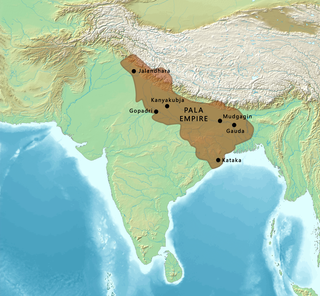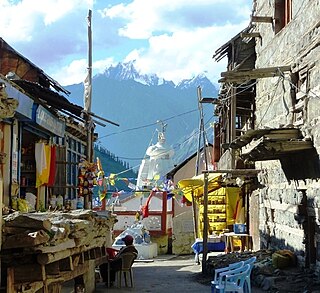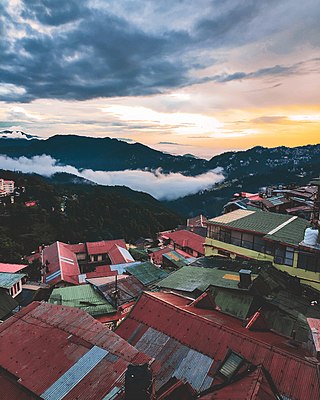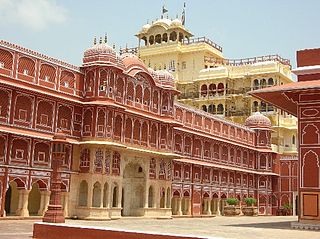
The Pāla Empire was an imperial power during the post-classical period in the Indian subcontinent, which originated in the region of Bengal. It is named after its ruling dynasty, whose rulers bore names ending with the suffix Pāla. The empire was founded with the election of Gopāla as the emperor of Gauda in late eighth century CE. The Pala stronghold was located in Bengal and eastern Bihar, which included the major cities of Gauḍa, Vikramapura, Pāṭaliputra, Monghyr, Somapura, Ramavati (Varendra), Tāmralipta and Jagaddala.

The Sena dynasty was a Hindu dynasty during the early medieval period on the Indian subcontinent, that ruled from Bengal through the 11th and 12th centuries. The empire at its peak covered much of the north-eastern region of the Indian subcontinent. The rulers of the Sena Dynasty traced their origin to the south Indian region of Karnataka.

Medieval India refers to a long period of post-classical history of the Indian subcontinent between the "ancient period" and "modern period". It is usually regarded as running approximately from the breakup of the Gupta Empire in the 6th century CE to the start of the early modern period in 1526 with the start of the Mughal Empire, although some historians regard it as both starting and finishing later than these points. The medieval period is itself subdivided into the early medieval and late medieval eras.

Kullu is a municipal council town that serves as the administrative headquarters of the Kullu district of the Indian state of Himachal Pradesh. It is located on the banks of the Beas River in the Kullu Valley about 10 kilometres (6.2 mi) north of the airport at Bhuntar, Kullu.

Rewalsar or Tso Pema in Tibetan is a small town and a pilgrimage place in a nagar panchayat in Mandi district in India. It is located in the state of Himachal Pradesh. The local name for Rewalsar is Tri Sangam. Rewalsar Lake is a tourist spot in the area.

Tira Sujanpur, also known as Sujanpur Tira or Sujanpur Tihra, is a town and municipal council in the Hamirpur district of Himachal Pradesh. Founded in the 18th century by the Katoch dynasty, the town is located midst the Himalayan foothills on the southern bank of the Beas River. It was one of the centers of Kangra-style miniature paintings and Hindu temples built in an unusual blend of conventional Nagara architecture shrines with Mughal architecture palace, the latter decorated with floral murals of legends from the Ramayana and the Mahabharata.

Parashar Lake is a freshwater lake located at an elevation of 2,730 metres (8,960 ft) in the Mandi district of Himachal Pradesh, India. It lies 49 km (30 mi) east of the town of Mandi, and has a three storied pagoda-like temple dedicated to the sage Parashara situated on its bank. It contains a floating island.

The Eastern Ganga dynasty were a large medieval era Indian royal Hindu dynasty that reigned from Kalinga from as early as the 5th century to the mid 20th century. Eastern Gangas ruled much of the modern region of Odisha in three different phases by the passage of time, known as Early Eastern Gangas (493–1077), Imperial Eastern Gangas (1077–1436) and Khemundi Gangas (1436–1947). They are known as "Eastern Gangas" to distinguish them from the Western Gangas who ruled over Karnataka. The territory ruled by the dynasty consisted of the whole of the modern-day Indian state of Odisha, as well as major parts of north Andhra Pradesh, parts of Chhattisgarh and some southern districts of West Bengal. Odia language got official status in their regime following the evolution of the language from Odra Prakrit. The early rulers of the dynasty ruled from Dantapuram; the capital was later moved to Kalinganagara, and ultimately to Kataka and then to Paralakhemundi.
Lau is one of the seven Mohyal Brahmin clans of Punjab.
The Kanet is a caste found in the state of Himachal Pradesh in North India. They are generally regarded as a Thakur (noble) caste, even though they have sometimes been classified otherwise.There is the subcaste of kanets which is known as "Mukhiya".

Mandi Shivaratri Fair is an annual renowned international fair that is held for 7 days starting with the Hindu festival of Shivaratri, in the Mandi town of the Indian state of Himachal Pradesh.

Mandi is a major city and a municipal corporation in Mandi District in the Indian state of Himachal Pradesh. It is situated 145 kilometres (90 mi) north of state capital, Shimla in the north-west Himalayas at an average altitude of 880 m (2,890 ft) Mandi is connected to the Pathankot through National Highway 20 and to Manali and Chandigarh through National Highway 21. Mandi is approximately 184.6 km (114.7 mi) from Chandigarh, the nearest major city, and 440.9 km (274.0 mi) from New Delhi, the national capital. In the 2011 Indian census, Mandi city had a population of 26,422. Mandi district is currently the 4th largest economy in the state. Mandi has the second highest sex ratio of 1013 females per thousand males, in the state.

The Sri Trilokinath ji Temple is in a village of same name 6 km south of the left bank of the Chaṅdrābhāgā or Chenab River, and about 9 km from the village of Udaipur, in the Lahul and Spiti District of Himachal Pradesh, India. It is sacred to both Tibetan Buddhists and Hindus. The glittering white-painted temple is situated on a cliff at the end of a village street. Its altitude is 2,760 metres (9,055 ft).
Siokot was a state in India that preceded the princely state of Mandi, which was founded in 1527. Formerly part of the Kingdom of Suket in the Punjab Hills, the rajput dynasty traditionally goes back to 765 AD. In about 1100, Vijaya Sen had two sons, Sahu Sen who ruled over Suket and Bahu Sen who ruled over Kullu. Bahu Sen's descendants emigrated to Kullu until the tenth descendant, Kabakha Sen was killed by the Raja of Kullu and his son had to flee to Siokot, not very far from the present city of Mandi, Himachal Pradesh, which was founded during Ajbar Sen's rule.

Mandi State was a native state within the Punjab, later the Punjab States Agency, with the town of Mandi as its capital. The state of Mandi, which included two towns and 3,625 villages, was part of the States of the Punjab Hills. It was located in the Himalayan range, bordering to the west, north, and east on the British Punjabi district of Kangra; to the south, on Suket; and to the southwest, on Bilaspur. As of 1941, population of Mandi State was 232,598 and area of the state was 1,139 square kilometres (440 sq mi).

Suket State was one of the Princely states of India during the period of the British Raj. The capital of the state was Pangna. Its last ruler signed the accession to the Indian Union on 15 April 1948. Formerly it belonged to the States of the Punjab Hills and currently, it is part of the Indian state of Himachal Pradesh. The present-day Mandi district was formed with the merger of the two princely states of Mandi and Suket.

The Masrur Temples, also referred to as Masroor Temples or Rock-cut Temples at Masrur, is an early 8th-century complex of rock-cut Hindu temples in the Kangra Valley of Beas River in Himachal Pradesh, India. The temples face northeast, towards the Dhauladhar range of the Himalayas. They are a version of North Indian Nagara architecture style, dedicated to Shiva, Vishnu, Devi and Saura traditions of Hinduism, with its surviving iconography likely inspired by a henotheistic framework.

Tourism in Himachal Pradesh relates to tourism in the Indian state of Himachal Pradesh. This is popularly renowned for its Himalayan landscapes and popular hill-stations. Many outdoor activities such as rock climbing, mountain biking, paragliding, ice-skating, trekking, rafting, and heli-skiing are popular tourist attractions in Himachal Pradesh.

Rajput architecture is an architectural style associated with the forts and palaces of the many Rajput rulers. Many of the Rajput forts are UNESCO World Heritage Sites and popular tourist attractions.

There are 51 Shaktipeeth of Goddess Sati all over the country, one of the main Shaktipeeth is Goddess Kamakhya, where the vaginal part of the Goddess was fallen, apart from this, there are various temples of maa Kamakhya all over the country, one of which is located in the famous village Jai Devi of Sunder Nagar in Mandi district of Himachal Pradesh, which is famous far and wide due to its beliefs and miracles." Kamaksha " word means the goddess who fulfills all kinds of desires.






















